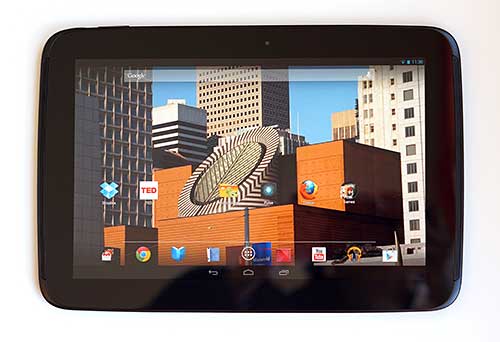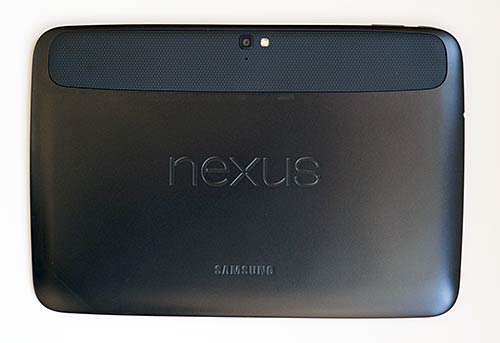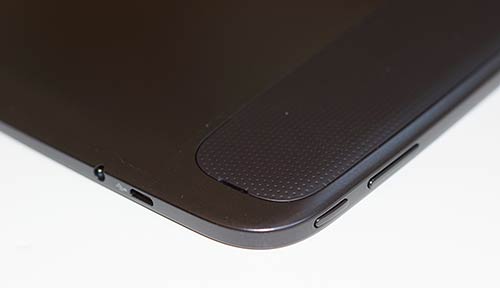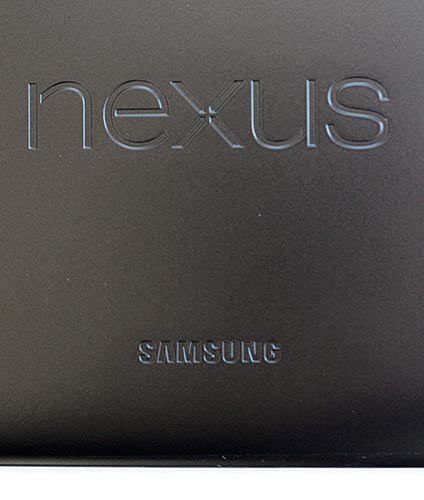The Nexus 10 is Google's first 10 inch tablet, and it's a winner. Made by Samsung, the tablet showcases Samsung's ability to make a very slim and appealing tablet with a blockbuster screen, minus the super-slippery gloss plastics found on Samsung brand tablets. The Nexus 10 has a 10.1" WQXGA 2560 x 1600 PLS display that's incredibly sharp, very bright and has balanced colors. It's every bit as good as the iPad with Retina Display when it comes to display quality. At 300 ppi, even tiny text is clear and easy to read and photos and videos look superb. Corning Gorilla Glass 2 and a bonded display make for a durable display.

Performance and Horsepower
This is the first Android product with the 1.7GHz Exynos 5 Dual CPU, and it's fast. Yes, it's only a dual core vs. the quad core Exynos 4 found in the Samsung Galaxy Note 10.1, Samsung Galaxy SIII and Galaxy Note II, but it not only benchmarks as well, but it feels supremely fast. Android 4.2 Jelly Bean with Project Butter speed optimizations no doubt help, but it makes our Nexus 7 running the same OS feel a tad sluggish. The Nexus 10 played 1080p MPEG4 high profile video, DivX video and YouTube 1080p streaming video perfectly to the internal display and to our HD TV via HDMI cable and it even played our 2560x 1440 4k ppi video test file using the stock video player. Nice. Challenging games like N.O.V.A. 3, GTA III, Bard's Tale (3.5 gig version) and Beach Buggy Blitz played smoothly with good frame rates. We definitely recommend this to gamers in the market for an Android tablet. The Nexus 10 has 2 gigs of RAM and your choice of 16 or 32 gigs of storage. The bad news? There's no microSD card slot and no USB host for external flash drives and hard drives.
Additional Features and Pricing
While the Nexus 7 goes after the budget segment, the Nexus 10 isn't bargain-priced vs. competing Android tablets. The 16 gig is $399 and the 32 gig is $499. But you get top notch features for the price (other than the lack of external storage, which Google abhors). There's dual band WiFi with MIMO, Bluetooth, NFC with dual side NFC, a GPS and micro HDMI out. The tablet has a sharp 1.9MP front camera and a decent 5MP rear camera with LED flash that can shoot 1080p video and still captures simultaneously. The Nexus 10 has haptic feedback, an ambient light sensor, digital compass, gyro and an ample 9,000 mAh battery.

Design and Ergonomics
Front an aesthetic standpoint we're conflicted. On the one hand the tablet feels solid and strong and we adore the rubbery black soft touch finish on the back. It's thin at 0.35 inches and reasonably light at 1.33 pounds. But the rounded sizes look a little like a kid's tablet, the bezel is fairly large (though that does allow for plenty of space to grip the tablet) and it's neither pretty nor sexy. But it's well made with no flex and it feels absolutely great in hand. It's just not a head-turner. The buttons are easy to operate but aren't prone to accidental activation, and the Nexus 10 even has a notification LED below the display, a rarity on tablets. The tablet doesn't get hot, even when playing challenging 3D games or streaming HD video.

We love the front-facing stereo speakers that are similar to the Samsung Galaxy Tab 2 and Note 10.1 tablets: they line the sides of the display and thus aren't muffled by a table or your hands. Sound volume is good for a tablet and quality is decent. As always, the best sound quality comes from wired headphones and Bluetooth speakers and headphones, and there the Nexus 10 doesn't disappoint.
 |
Jelly Bean, Speed and What About Adobe Flash Player?
Stability and speed have been top notch after a rocky start where installing apps in groups of 10 has the tablet crash and reboot twice. Since then it's been silky smooth and responsive and stable. In fact, it's the quickest Android tablet we've tested in terms of actual user experience, and it doesn't feel slow compared to the iPad with Retina Display. The stock Chrome web browser is more prone to crashing than other apps, but so far it's been well behaved. Android 4.2 Jelly Bean and Chrome support HTML5 video but not Adobe Flash Player. We did install the free Boat browser and side-load Flash Player from Adobe's website and had success with Flash and sites like Amazon Instant Video.
Since this is a Google reference device, you get vanilla Android with no manufacturer UI add-ons like TouchWiz or HTC Sense. Advanced users and Android purists will love this: the tablet is easy to root and loading custom ROMs is straightforward. Average non-techie consumers might feel a little lost since there's no extra software bundle to get you going with Office docs, alternative video players or third party utilities. You can download these from the Google Play Store, but newbies may have no idea what apps to look for. Google's end user support is bare bones at best, making the tablet a better choice for Android veterans and those who frequent forums for peer support.
Wireless
This is a WiFi-only tablet, and there's currently no 3G or 4G option. If you're not in WiFi range, you can use your smartphone's mobile hotspot feature, if you have it. We found the dual band WiFi 802.11b/g/n connection speed and range to be average, with good throughput on 5GHz 802.11n up to 35 feet from the wireless router, through 2 sheetrock walls. Beyond 35 feet, data speeds gradually taper off in an expected fashion.
The tablet also has NFC, which is handy for wireless transfers between NFC devices, but we suspect you won't be tapping the 1.4 lb. Nexus on the checkout terminal at the local Starbucks for Google Wallet payments. Bluetooth 3.0 works with keyboards, mice, game controllers (we tested it with the GameStop Bluetooth game controller for Android), headphones and speakers.
Cameras
Everyone likes to make fun of 10 inch tablet cameras. Yes, it's a large device to wave around when shooting photos and video, but your best camera is the one that's handy. The front 1.9MP camera clearly shares DNA with the Samsung Galaxy S III and Samsung Galaxy Note 10.1 front cameras. It's bright and sharp and makes for very good quality video chat over Google video chat and Skype. The rear 5MP camera won't win any resolution wars now that higher end smartphones sport 8MP cameras, but 5MP is enough to get reasonably detailed shots (assuming you can hold the big tablet still enough to avoid hand shake and blur). The back camera actually takes pleasing shots and it can shoot 1080p video. In fact, you can take still shots while filming video. Google's latest circular camera control UI leaves me cold: it requires fine motor coordination, something you don't want to deal with when trying to capture photos quickly and it's just not as easy as dedicated on-screen buttons. But it gets the job done and there are basic effects, white balance, EV along with panorama and 360 degree panorama options.
Battery Life
The tablet has a beefy 9,000 mAh Lithium Ion Polymer sealed inside its svelte chassis. In our tests battery life has been very good with average use that includes lots of web browsing, 1 hour of streaming video playback, background email and social network updates and 30 minutes of gaming. The tablet lasted us an average of 3 full days on a charge with moderate use. If you spend hours playing games like Dead Trigger or Need for Speed, the battery will run down sooner since gaming is the biggest power consumer.
Though the Nexus 10 has a Pogo Pin charger port on the bottom edge, that charger isn't included in the box and it doesn't seem to exist as of this writing. It would attach magnetically, much like the MS Surface RT tablet, but that's all we know since they aren't available for sale. You do get Samsung's standard 2 amp charger (the same that's been included with every Samsung Android tablet to date) and a USB to micro USB charging and data transfer cable.
Unlike Samsung-branded tablets that have a 30 pin proprietary multi-purpose port, the Nexus 10 uses the micro USB port for charging and data transfer over USB. That means Samsung's dongle adapters for USB host and keyboard docks will not work with the Nexus 10.
Comparing the Nexus 10 vs. the Samsung Galaxy Note 10.1
These are honestly two very different tablets once you move beyond the fact that they're both 10" Android tablets made by Samsung. The Note 10.1 is a much more consumer-focused product and the digital Wacom pen sets it apart from most other tablets on the market. Nexus products until recently targeted tech enthusiasts, particularly Android fans. The budget priced Nexus 7 brought the brand to the mainstream, but we still think of the 10" model as an enthusiast product.
Galaxy Note 10.1 Pro:
- Digital pen is a godsend for artists and avid note-takers. It's also very useful for digitally signing documents.
- Excellent custom software bundle: S-Note for notes and drawing, floating application feature, side-by-side app feature for multi-tasking. Plus a good set of starter apps including an MS Office compatible suite that makes life easier for novice users who don't have an established library of apps in their Google Play Store account.
- Solid performance and specs, microSD card slot for storage expansion and optional USB host with dongle adapter.
- Nice looking design. Available in two colors.
- Samsung has decent tech support, which is important for average users. Google's tech support is pretty weak: they'd rather send you to the brand maker for support which is ironic for Nexus Google-branded products.
Nexus 10 Pro:
- One of the best displays on the market, it's noticeably better than the Note 10.1 display. That doesn't mean the Note 10.1 has a poor display (it doesn't), rather than Nexus 10's display is just that fantastic.
- You'll be the first to get Android OS updates. It's also easy to root the tablet and load custom ROMs.
- Though the Galaxy Note 10.1 is a responsive tablet, the Nexus 10 feels even faster when navigating the UI, likely thanks to the clean OS without Samsung's TouchWiz UI on top.
- The Nexus 10 is grippy not slippery. Good for those who hate gloss plastics.
Conclusion
I'll be honest, I didn't expect to like the Google Nexus 10 that much. It isn't that I don't like Android, in fact Android is my main squeeze, but on paper the Nexus 10 didn't set my heart on fire. Once I got my hands on the tablet that changed. Why? The display is drop-dead gorgeous and it's faster and smoother than any other Android tablet on the market, including the Nexus 7 that seemed to get a little slower with the Android 4.2 update. The Nexus 10 also feels great in hand with friendly tapered sides, good balance, an excellent rubbery soft touch finish and moderate weight. I confess I don't much care for the industrial design, but I'll take good ergonomics over vanity any day.

Post a Comment